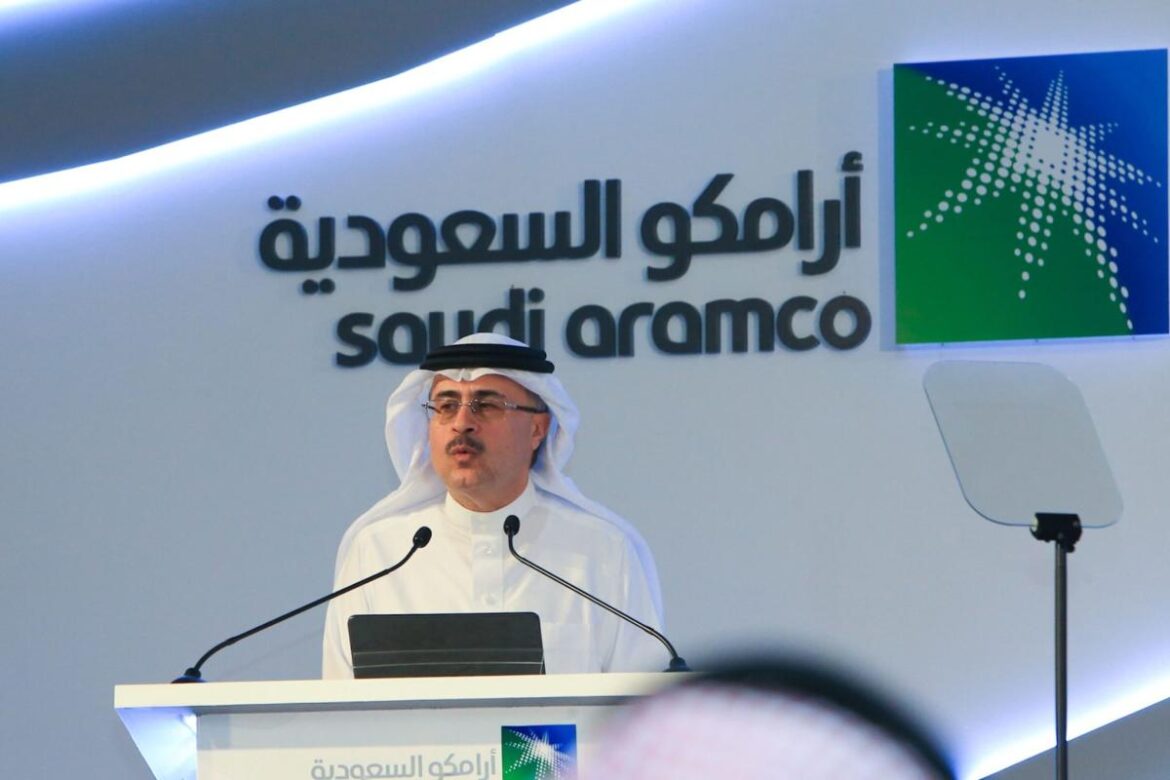Shares of the company are up roughly 1% Monday and hovering around all-time highs.
Source link
profits
The world’s third-biggest company just saw its profits plummet 38%—but still paid shareholders $19.5 billion in dividends
Saudi Aramco, the third most valuable company in the world, saw its profits plummet 38% in the second quarter of the year as energy prices cooled.
Spiraling energy costs have squeezed household budgets over the past year while huge windfalls were recorded by oil and gas producers—including Aramco, which raked in a $161 billion profit in 2022, the highest ever recorded by an energy firm.
However on Monday the company—which is valued at more than $2.1 trillion, making Apple and Microsoft the only public companies in the world with higher valuations—reported that its net profit had fallen to 113 billion riyals ($30 billion) for the three months to June, a drop of almost 40% from a year earlier.
Aramco, which recently ranked No. 2 on the Fortune Global 500 list, cited lower crude oil prices and weaker margins in refining and chemicals as the drivers behind the decline.
Despite shrinking profits, Aramco said it would be paying a $19.5 billion dividend to shareholders for the second quarter—with the payout set to be delivered in the third quarter of the year. That was up from its $18.8 billion dividend payout for the second quarter of 2022.
Shareholders will also be receiving $19.5 billion in dividends for the first quarter of the year, the company added—meaning investors in the company would get a $39 billion payout for the first half of 2023, up from $37.5 billion a year earlier.
From the third quarter onward, Aramco said it would begin paying performance-based dividends, a move that will continue for six consecutive quarters and begin with a $9.87 billion payout.
The company labeled its dividend payouts “sustainable and progressive.”
“Our strong results reflect our resilience and ability to adapt through market cycles,” Aramco CEO Amin Nasser said on Monday. “We continue to demonstrate our long-standing ability to meet the needs of customers around the world with high levels of reliability. For our shareholders, we intend to start distributing our first performance-linked dividend in the third quarter.”
The Saudi state is Aramco’s biggest shareholder. The government directly owns more than 90% of the company, while the sovereign Public Investment Fund and its subsidiary Sanabil hold a further 8% of the firm’s shares, according to news agency Reuters.
Turbulent times
Aramco isn’t the only energy giant to have boosted dividends amid falling profits, with the Saudi powerhouse—the largest exporter of oil in the world—following in the footsteps of Shell and BP.
Much of the world, particularly Europe, was plunged into an energy crisis following Russia’s invasion of Ukraine in February 2022. The ostracizing of Moscow, given its position as a major energy producer, shook already undersupplied energy markets thanks to economic sanctions that included a ban on imports of Russian oil.
Oil giants scored record profits last year in the wake of the energy crisis, but more recently have seen their revenues dented by cooling energy costs.
Brent crude oil prices edged slightly lower on Monday, trading at just below $85 a barrel by 9:30 a.m. EST.
Used as a benchmark for much of the oil traded around the globe, Brent has been staging a recovery in recent weeks after dipping below $72 a barrel—a far cry from mid-2022, when the price surpassed $100.
Quincy Krosby, chief global strategist for LPL Financial, told Fortune on Monday that Aramco wasn’t wrong to project a resilient market for oil going forward.
“The global economic backdrop, as central banks complete their respective rate hike campaigns, coupled with a softer dollar, is expected to provide a markedly more resilient underpinning for oil prices,” he said.
He added: “With tighter supplies, oil prices have begun a steady ascent with expectations that prices will end the year higher as momentum—and the global economy—continue to recover. Saudi Arabia, the de facto head of OPEC+, has signaled it will continue to adjust production in order to ‘stabilize’ prices, but it’s clear they want to propel prices toward $90 a barrel.”
This story was originally featured on Fortune.com
More from Fortune:
5 side hustles where you may earn over $20,000 per year—all while working from home
Looking to make extra cash? This CD has a 5.15% APY right now
Buying a house? Here’s how much to save
This is how much money you need to earn annually to comfortably buy a $600,000 home
What is CryptoSlate Alpha?
A web3 membership designed to empower you with cutting-edge insights and knowledge. Learn more ›
Connected to Alpha
Welcome! 👋 You are connected to CryptoSlate Alpha. To manage your wallet connection, click the button below.
Oops…you must lock a minimum of 20,000 ACS
If you don’t have enough, buy ACS on the following exchanges:
Connect via Access Protocol
Access Protocol is a web3 monetization paywall. When users stake ACS, they can access paywalled content. Learn more ›
Disclaimer: By choosing to lock your ACS tokens with CryptoSlate, you accept and recognize that you will be bound by the terms and conditions of your third-party digital wallet provider, as well as any applicable terms and conditions of the Access Foundation. CryptoSlate shall have no responsibility or liability with regard to the provision, access, use, locking, security, integrity, value, or legal status of your ACS Tokens or your digital wallet, including any losses associated with your ACS tokens. It is solely your responsibility to assume the risks associated with locking your ACS tokens with CryptoSlate. For more information, visit our terms page.
BYD Stock: Warren Buffett-Backed BYD To See Q2 Profits Soar As Tesla Stock Hits 2023 High
BYD (BYDDF) signaled second-quarter earnings nearly tripling on the back of record deliveries of electric vehicles. BYD stock rallied Friday for a fifth straight session. Tesla stock hit a 2023 high intraday.
X
The Chinese EV and battery giant, backed by Warren Buffett’s Berkshire Hathaway (BRKB) and an archrival to Tesla (TSLA), expects its net profit for the first half of the year to reach RMB 10.5 billion-RMB 11.7 billion ($1.64 billion). That would be up as much as 225% year over year, CnEVPost.com reported Friday, based on a regulatory filing.
Given Q1 net profit of RMB 4.13 billion, that implies Q2 net profit will reach RMB 6.37 billion-RMB 7.57 billion. The high end of the range would mark an all-time high. It would also be up as much as 171% year over year and up as much as 83% vs. Q1.
In Q2, BYD delivered 700,244 EVs, including hybrid vehicles. That was capped off with a strong June, which saw monthly sales surpass 250,000 units for the first time.
Tesla also posted record Q2 sales. Tesla delivered 466,140 EVs globally last quarter, including 247,217 China-made cars.
Among China EV startups, Li Auto (LI) led Q2 sales by a margin. But Nio (NIO) and XPeng (LI) saw sales improve on the back of new models and price cuts.
Tesla slashed prices in China at the start of the year to stimulate sales. That fueled an EV price war, with rivals like BYD also cutting prices or launching cheaper new models.
Market Rally Had A Great Week, But Here’s What To Do Now
BYD Stock, Nio Stock
In stock market trading Friday, shares of BYD advanced 1.6% to 34.53. BYD stock, which trades over the counter, rose for a fifth consecutive day, gaining 4% for the week. Shares bounced from their 50-day moving average last week and have moved off their 21-day line this week.
BYD stock arguably is still actionable from those key levels. The EV giant also could be forging a new consolidation above a prior cup-with-handle base.
Tesla stock rose 1.3%, hitting a 2023 high at 285.30 intraday but closing at 281.38. Tesla earnings are due on July 19.
The startup EV stocks, including Li Auto, Nio and XPeng, all fell slightly Friday. For the week, Nio stock outperformed startup rivals, climbing 5.5%. Wall Street sees Nio poised for a stronger second half of 2023 on the back of new and more affordable Nio electric vehicles.
BYD Battery News
Sources told Reuters Friday that China’s BYD has submitted a $1 billion investment proposal to build electric cars and batteries in India in partnership with a local company.
BYD has already made a small inroad selling electric vehicles in that market. Tesla is trying to get the green light for an Indian factory.
An unconfirmed social media post also indicated Friday that BYD it has started trial production of sodium-ion Blade batteries for energy storage systems.
YOU MAY ALSO LIKE:
These Are The 5 Best Stocks To Buy And Watch Now
Stocks To Watch: Top-Rated IPOs, Big Caps And Growth Stocks
Find The Latest Stocks Hitting Buy Zones With MarketSmith
Why This IBD Tool Simplifies The Search For Top Stocks
Looking For The Next Big Stock Market Winners? Start With These 3 Steps
Samsung’s Profits Likely to Tank to 14-Year-Low as Chip Sales Slow Down
Amid a major slowdown in the semiconductor market, Samsung’s operating profits for the April-June quarter could be the lowest since 2008. Samsung is focusing on expanding its presence in the field of artificial intelligence (AI).
Samsung Electronics could see a major dip in its profits likely to tank as much as 96% on a year-on-year basis. It means that the profits for the company will be the lowest this quarter, in the last 14 years.
The major dent in the company’s bottom line comes as the tech giant’s cash cow business of chip sales is seeing a major slowdown. Samsung is the world’s largest chip manufacturer currently and the slowdown in the chips business has been eating majorly into the company’s profits.
Analysts at Refinitiv SmartEstimate note that the in the April-June quarter, the operating profit for Samsung shall drop to 555 billion won ($427 million). This would be a significant drop in the operating profits of 14.1 trillion won during the same quarter last year.
This is because the chip division, which has historically been the company’s main source of profit, is likely to experience losses of approximately 3 to 4 trillion won in the quarter. These losses can be attributed to the declining prices of memory chips and the reduction in inventory values.
If so, it would mean that Samsung will be recording the lowest quarterly profit since the fourth quarter of 2008. Back in that year, Samsung Electronics had reported a consolidated profit of 740 billion won.
Samsung Faces Brunt of Falling Chip Prices
During the last quarter, the price of DRAM memory chips – widely used in PCs, smartphones, and servers – continued to drop by 13-18%, as per TrendForce. This is because chip buyers refrained from purchasing new chips as well as used-up inventories, reports Reuters.
However, the decrease in prices of memory chips has slowed down compared to previous quarters. Experts predict that the prices will reach the lowest point around the third quarter and a significant recovery might not happen until 2024.
Despite the challenging market conditions, Samsung is focusing on expanding its presence in the field of artificial intelligence (AI). This includes areas like high bandwidth memory (HBM) and chip contract manufacturing.
In terms of its mobile business, Samsung is expected to report an operating profit of around 3.3 trillion won. This is because cost-cutting measures have offset a slight decline in smartphone shipments compared to the first quarter when Samsung released its latest flagship model.
Later this month in July, Samsung will be unveiling its latest foldable smartphone in Seoul. Analysts expect it to dominate the premium smartphone market at least until Apple releases its next iPhone version.
next
Artificial Intelligence, Business News, News, Technology News

Bhushan is a FinTech enthusiast and holds a good flair in understanding financial markets. His interest in economics and finance draw his attention towards the new emerging Blockchain Technology and Cryptocurrency markets. He is continuously in a learning process and keeps himself motivated by sharing his acquired knowledge. In free time he reads thriller fictions novels and sometimes explore his culinary skills.
You have successfully joined our subscriber list.
A step-by-step beginner’s guide to cryptocurrency trading: Strategies to maximize your profits
Guide to cryptocurrency trading
Cryptocurrency trading can be difficult to navigate for beginners, but with the right strategies and knowledge, it can be a profitable venture. In this beginner’s guide, we’ll cover the steps you need to take to get started with cryptocurrency trading and how to maximize your profits.
Step 1: Do your research
Before you begin trading, it’s important to understand what cryptocurrencies are and how they work. You should research the different types of cryptocurrencies available, such as Bitcoin, Ethereum, Ripple, and Litecoin, and their underlying technology. This will help you make informed decisions on which cryptocurrency to trade and when to buy or sell.
Step 2: Choose a trading platform
Once you have a basic understanding of cryptocurrency, the next step is to choose a trading platform. There are many different platforms available, each with its own features and fees. Popular trading platforms include Coinbase, Binance, and Kraken. It’s important to choose a platform that is reputable and user-friendly.
Step 3: Create an account and fund it
After selecting a trading platform, you need to create an account and fund it with fiat currency or crypto. Most trading platforms require identity verification before you can start trading, so be prepared to provide personal information.
Step 4: Develop a trading strategy
The key to successful cryptocurrency trading is having a solid trading strategy. There are many different strategies you can use, including:
• Day trading: Buying and selling cryptocurrencies quickly within a day in an attempt to make a profit from market fluctuations.
• Swing trading: Holding on to a cryptocurrency for a few days or weeks to take advantage of price movements.
• Positional trading: Holding on to a cryptocurrency for a longer period of time, usually months or years, with the hope of making a large profit from a significant price increase.
Step 5: Use technical analysis
Technical analysis involves using charts and indicators to predict market movements. This can be helpful in identifying trends and making informed buying and selling decisions. Some popular technical analysis tools include moving averages, the Relative Strength Index (RSI), and the Bollinger Bands indicator.
Step 6: Practice risk management
Cryptocurrency trading can be risky, so it’s important to practice risk management. This means setting stop-loss orders to limit potential losses and not investing more than you can afford to lose. Additionally, you should diversify your portfolio by investing in multiple cryptocurrencies rather than just one.
Step 7: Keep up with news and developments
The cryptocurrency market is constantly changing, so it’s important to stay up to date with news and developments in the industry. This will help you make informed decisions on when to buy or sell. You can stay informed by reading cryptocurrency news websites, social media, and attending cryptocurrency events.
In conclusion, cryptocurrency trading can be a profitable venture if done correctly. By following these steps and developing a solid trading strategy, you can maximize your profits and minimize your risk. Remember to always stay informed and practice risk management. Good luck and happy trading!






